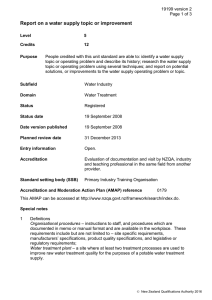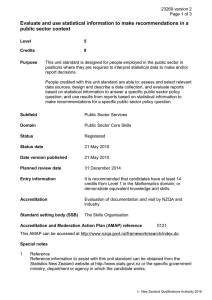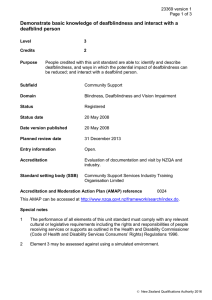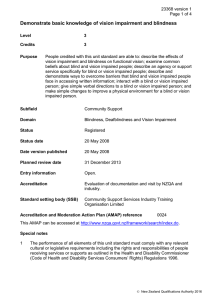Guide blind, deafblind, and vision impaired people
advertisement
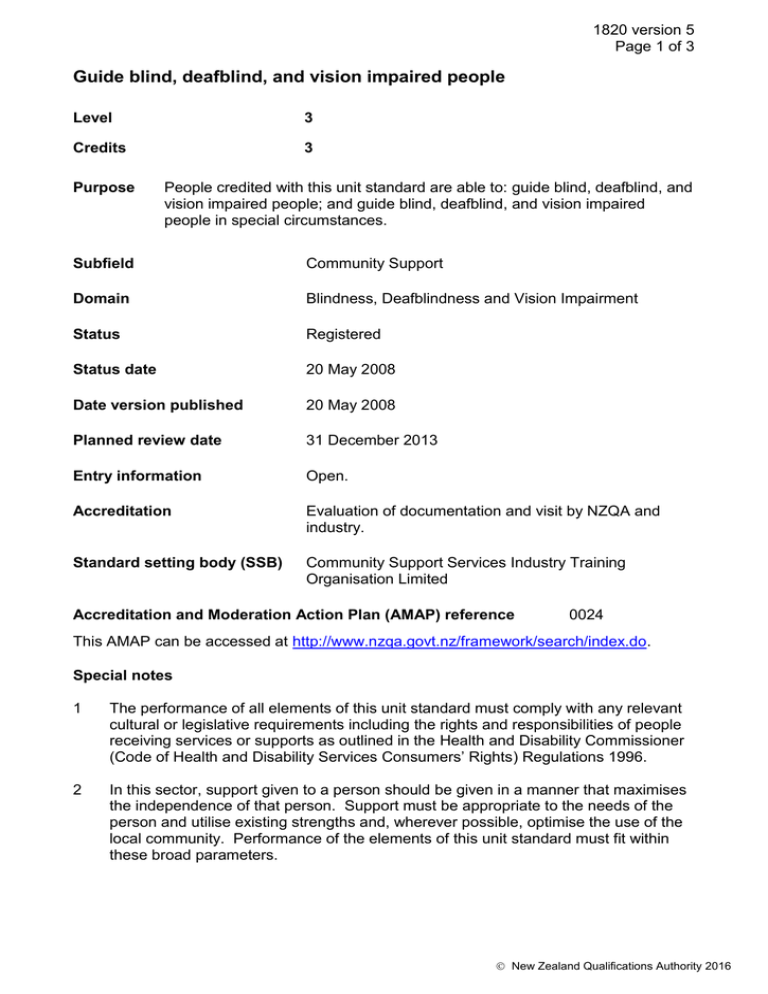
1820 version 5 Page 1 of 3 Guide blind, deafblind, and vision impaired people Level 3 Credits 3 Purpose People credited with this unit standard are able to: guide blind, deafblind, and vision impaired people; and guide blind, deafblind, and vision impaired people in special circumstances. Subfield Community Support Domain Blindness, Deafblindness and Vision Impairment Status Registered Status date 20 May 2008 Date version published 20 May 2008 Planned review date 31 December 2013 Entry information Open. Accreditation Evaluation of documentation and visit by NZQA and industry. Standard setting body (SSB) Community Support Services Industry Training Organisation Limited Accreditation and Moderation Action Plan (AMAP) reference 0024 This AMAP can be accessed at http://www.nzqa.govt.nz/framework/search/index.do. Special notes 1 The performance of all elements of this unit standard must comply with any relevant cultural or legislative requirements including the rights and responsibilities of people receiving services or supports as outlined in the Health and Disability Commissioner (Code of Health and Disability Services Consumers’ Rights) Regulations 1996. 2 In this sector, support given to a person should be given in a manner that maximises the independence of that person. Support must be appropriate to the needs of the person and utilise existing strengths and, wherever possible, optimise the use of the local community. Performance of the elements of this unit standard must fit within these broad parameters. New Zealand Qualifications Authority 2016 1820 version 5 Page 2 of 3 3 The context of assessment should be a safe indoor or outdoor environment that is familiar to the candidate being assessed. Assessment can take place in a simulated environment. 4 Element 1 must be assessed against by demonstrating use of the techniques. Element 2 will ideally be assessed against by demonstrating the use of the techniques but may, where this is not practical, be assessed against by describing modifications to demonstrated techniques to suit the special circumstances. 5 Definition Preferred practice refers to practice that is endorsed as acceptable by the Royal New Zealand Foundation of the Blind (RNZFB), or equivalent organisation. This is available to people involved in training from the training manager, RNZFB, Private Bag 99941, Auckland. Elements and performance criteria Element 1 Guide blind, deafblind, and vision impaired people. Performance criteria 1.1 Guiding techniques accord with preferred practice. Range people – child, adult, older person, deafblind person; guiding techniques – position and grip, reversing direction, transferring sides, narrow passageways, negotiation of stairs, negotiation of closed doors, seating, guiding two people. Element 2 Guide blind, deafblind, and vision impaired people in special circumstances. Performance criteria 2.1 Guiding techniques for guiding a person using a wheelchair accord with preferred practice. Range 2.2 positioning, pacing, negotiating doorways, changing direction, changing gradients, giving environmental information. Guiding techniques for guiding a person with a mobility aid accord with preferred practice. Range may include but is not limited to – guide dog, long cane, support cane, electronic travel aid. New Zealand Qualifications Authority 2016 1820 version 5 Page 3 of 3 Please note Providers must be accredited by NZQA, or an inter-institutional body with delegated authority for quality assurance, before they can report credits from assessment against unit standards or deliver courses of study leading to that assessment. Industry Training Organisations must be accredited by NZQA before they can register credits from assessment against unit standards. Accredited providers and Industry Training Organisations assessing against unit standards must engage with the moderation system that applies to those standards. Accreditation requirements and an outline of the moderation system that applies to this standard are outlined in the Accreditation and Moderation Action Plan (AMAP). The AMAP also includes useful information about special requirements for organisations wishing to develop education and training programmes, such as minimum qualifications for tutors and assessors, and special resource requirements. Comments on this unit standard Please contact the Community Support Services Industry Training Organisation Limited enquiries@cssito.org.nz if you wish to suggest changes to the content of this unit standard. New Zealand Qualifications Authority 2016







